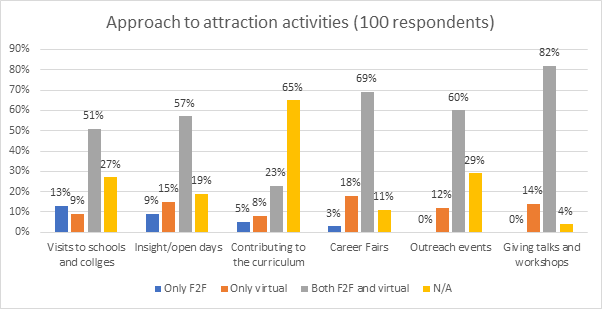Throughout the last two years employers have had a chance to re-evaluate how they attract graduates. ISE researcher Nicola Thomas considers how employers are weighing up resource intensive face-to-face on-campus attraction with other activities that are more scalable.
With organisational pressures and a tight labour market, employers are working hard to ensure that recruitment teams are getting the most return on investment when it comes to attracting graduates.
What was once standard, attending in person careers fairs and giving in person talks on campus, has now been re-evaluated.
In ISE’s June poll we found that in general, employers expect to do most of their attraction hybrid (both face to face and virtually), however there has been an increasing shift away from only face-to-face career fairs, with only 3% of employers stating they will attend these events face-to-face only.

Although different organisations are approaching campus attraction activities differently, we have identified three main reasons for a continued shift to virtual, or a movement back to in person.
These main reasons are: hybrid enables better use of organisational resources, face-to-face leads to better student engagement, hybrid enables wider attraction.
We asked employers why they were taking a more face-to-face, hybrid or online approach this year. Three core themes emerged:
1. Hybrid enables better use of organisational resources
Employers said they saved “resources and volunteers time”, “with our resource spread across EMEA, it’s easier and cheaper to manage these events virtually”, it “provides greater reach, increase accessibility and helps with a small recruiting team”, and “allows more flexibility and options for people to attend”.
2. Face to face leads to better engagement & is in demand from students
Employers said that “face to face is way more effective”, “students benefit from meeting employers face to face”, “we are meeting the demand for F2F from students”, “nothing beats in-person interaction”, and that “we have started doing F2F again to be competitive”.
3. Hybrid enables wider attraction and more targeted attraction
Employers said that retaining virtual reach has “enabled us to be able to reach the most amount of candidates/potential applicants”, “hybrid allows us to be more agile and reach more people”, “a blended approach means we’re able to have a broader reach, target diversity more accurately”, “we decided to continue with an online approach this year given how we were reaching a wider audience via this means” and that they are “trying to capitalise on the extra reach and accessibility that virtual can bring events”.
This highlights how different employers are using different approaches according to team capacity, goals and return on investment.
However, considering the current fight to get and keep graduates, time will tell if a shift towards a more virtual or hybrid approach to campus attraction does enable companies to secure the talented they need. Or, will next year usher changes to more local and personal attraction strategies as employers fight to attract graduates?
Read more insight and data from ISE research


0 Comments